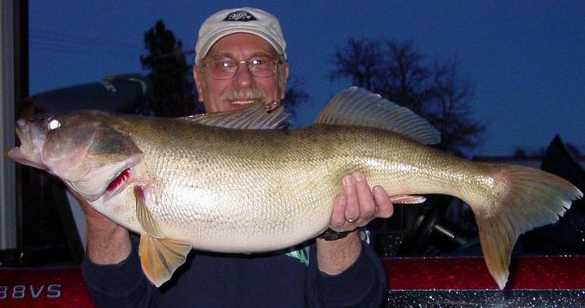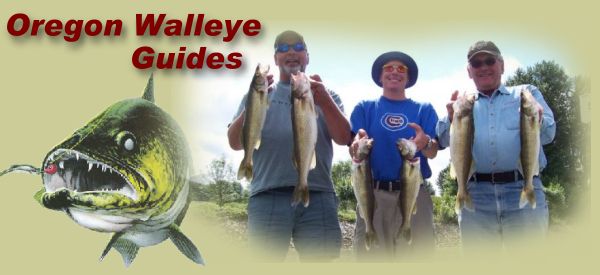Mid January through February
is the time to fish, especially if you have your eye on a real wallhanger.
This is also the best time to catch the big females.
Fishing will remain good for
numbers of keeper size fish as the weather warms, but the fisherman that
wants a really big one should plan their trip early in the year.
Water temperature, more than
the time of year, is what triggers the bite. April is usually the best
month, but the Columbia has been slow to warm this year, so the peak could
easily stretch into May.
The mighty Columbia River
offers the best walleye fishing in Oregon, possibly in the country. Brownlee
Reservoir is the primary lake for walleye fishing in Oregon.
Walleye are
also found in some of the smaller lakes and rivers. The Columbia River
has produced both the Oregon state record walleye and the
Washington state
record walleye.
The next world record will likely come from the Columbia River.
If you would like a shot at getting your name in the record books give us a
call.
|
 Oregon Walleye Oregon Walleye |
 Washington
Walleye Washington
Walleye |
 |
 |
 |
 |
 |
|
25 lbs - 0 oz |
25 lbs - 0 oz |
 |
 |
|
19 lbs - 15 oz |
19 lbs - 3 oz (photo)->> |
 |
 |
|
38 - 60 Degrees |
38 - 60 Degrees |
 |
 |
|
Prefers slightly stained to murky water with
little or no current. |
Prefers slightly stained to murky water with
little or no current. |
Oregon walleye
spawn in spring and when they have the option will choose to
migrate from the lake or river up into feeder streams to spawn. If this
option is not available they seek out shallow bars or shoals with clean
bottom surfaces near deep water.
This toothy fish will eat virtually anything it can catch and get in its
mouth. They prefer small fish and will eat crustaceans, worms and insects.
They tend to be somewhat wary and prefer the safety of deeper darker water.
/font>
Where to
go
One of the best places to
try your luck has traditionally been the reach of river below the John Day
Dam The floods of '96 slowed the fishing down, but walley have
really rebounded in this area. This is a great area, whether you're
seeking a monster or looking to take
home some tasty walleye fillets.
Compared to many other
states, the limits here are generous. Currently there is no limit on
walleye, minimum size is 18 inches, only one of which can be over 24 inches.
However, many guides who work the area suggest you release
the big females after a photo or two, to insure they keep contributing their
"big" genes to the gene pool. Likewise, they also encourage you to release
most of the smallest keeper-sized fish to provide the recruitment necessary
to sustain this quality fishery.

Photo above: Ken
Bain of Spokane poses with a 14-pound, 7-ounce trophy walleye he
caught on the lower Spokane River near Fort Spokane on Feb. 20, 2010.
Full story The Spokane River is a tributariy of the Columbia River.
Here are your best bets
for John Day walleye:
The Deadline:
Walleye can be caught from a number of different locations below the dam.
The Deadline is a
good hole to take some big ones, but it's a difficult stretch to fish, and
not a place for beginners. It's very snaggy and the currents can be tricky.
There are also some nasty shoals and rocks that lie just under the surface
of the water. If you're not familiar with the area, you can get into trouble
quickly. I strongly suggest you fish with someone who's done it a couple
times before.
Preacher's Eddy:
Just downriver from The Deadline, Preacher's Eddy has long been famous for
its big fish.
While not as difficult to fish as The Deadline, this stretch has an
undulating bottom, running anywhere from 12 to 32 feet. Schneider considers
this prime depth for walleye. As you troll or drift downstream, you must
continually adjust the depth of your bait to keep it on the bottom.
The Willows and
downstream:: The Willows, just down from Preacher's
Eddy near the Washington bank, is an easier stretch to fish.
The bottom is less irregular and
it's easier to stay in the strike zone. While some good walleye are taken
here, this stretch is better known for eating-sized fish.On the Oregon side,
you'll find 106 Hole, another good spot. In fact, there is good water just
about everywhere.
A good trick is to look for
the buoys of the tribal fishermen, since they're almost always set in the
right depths for walleye.
How to
hook 'em
We were fishing with
nightcrawlers rigged on bottom-walkers, one of the easiest ways to catch
walleye in the Columbia, especially when the winds are up. The rig is
simple. Attach the bottom-bouncer to your main line, and run a 4 or 5-foot
leader from the walker to the bait. Set a few beads and a Spin-N-Glo on the
line directly above a double hook rig.
Chartreuse and green are good
colors. Pass the worm's head through the first hook and set the stinger hook
in the worm, an inch or 2 below the first one, leaving some slack in the
line between the hooks. This allows for the stretch of the worm once you've
dragged it through the water for a while.
Let the bait to the bottom
and troll downstream. Be sure to keep adjusting your line so that the
bouncer is ticking the bottom at all times. If you're not on the bottom,
you're not fishing for walleye.
A last
word
There are boat launches
close to the action on both sides of the river: one at Rufus on the Oregon
side, another at Maryhill in Washington. Even though the run to the action
is short, the wind in the Gorge is treacherous, and you should check the
forecast in advance — and keep an eye on the weather at all times.
Book your trip now!
Oregon Walleye
Fishing Guide
541-969-2537
E-mail:
elmerhill@charter.net
